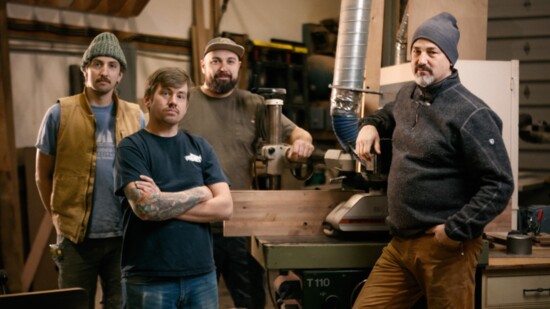Ed Szczepanik is one of a dying breed. This gifted artisan is among an elite but dwindling brotherhood of true craftsmen. In a world of mass production and instant gratification, Szczepanik and his EAD Woodwork tradesmen lovingly craft furniture with precision, patience, and passion. Artistry is unfolding in this York, Maine shop.
Szczepanik feels an attachment to everything that comes out of his shop, whether his own handiwork or another worker’s. This dedicated business owner is involved in the process from beginning to end. “Each finished piece is a part of me,” he says. “I know where the wood came from. I’ve seen every tree first and followed its journey from the time we sawed it and dried it until we made something out of it.”
His love for his craft began in a high school shop class and flourished during his two years in a woodworking program at the Worcester Center for Professional Crafts. This led to a New York City apprenticeship to a cabinet maker, and in 1994, the enterprising young Szczepanik found a business partner and opened his own shop in Durham, New Hampshire.
Working in cabinetry “to earn a living,” the creative Szczepanik yearned to craft furniture. The time finally came when the furniture industry appeared to have room for him. More consumers were in the market for distinctive, traditionally crafted pieces. Seizing his chance, in 2001, he sold the business to his partner and boldly ventured out on his own, opening EAD Woodwork in York. In 2023, he added the Portsmouth showroom, Urban.
Szczepanik’s work is deeply entwined with his tremendous reverence for nature’s splendor. “My concentration is on showcasing Mother Nature’s work, not mine,” he says, humbly. “It’s about celebrating the beautiful materials she supplied us with.”
He carries his respect for the natural world to the harvesting of his raw materials. “The trees we get don’t come on a tractor-trailer from somewhere I’ve never been,” he says. “They’re not cut down from a forest. They’re from someone’s yard. These are urban trees.”
Szczepanik understands the almost mystical attachment people have to their trees. He likes to say that every tree has a story. Someone grew up with that tree in their yard, soaring on a swing beneath its branches or gazing at its grandeur from their bedroom window. When age, disease, or a storm topple this giant that took so long to reach maturity, homeowners are devastated. Szczepanik feels an obligation to these once mighty trees to do something with the wood they leave behind.
Beyond the sustainability factor, the wood from these felled trees supplies Szczepanik with unique and lovely materials to work with. Much of this wood is impossible to find at a lumber yard. His favorite wood is not a specific species, but any tree uncommon to furniture making. Surprisingly, one of his most preferred woods is apple. “No one thinks of apple wood as lumber,” he says. “Everything about it is beautiful–it even smells nice to work with!”
Szczepanik holds one tree particularly dear: the ash. Like the craftsman brotherhood, it is a dying species. The majestic tree is rapidly disappearing, a victim of the voracious Emerald Ash Borer, an invasive beetle. “It’s heartbreaking,” he says. “The ash tree is the king of the forest in New England.” The saddened woodworker sings the praises of the beleaguered ash. “The wood is one of those honest materials the country was built on,” he says. “It’s a gorgeous, rugged hardwood.”
The ash tree itself is a striking example of nature’s artwork. Its sweeping, curved boughs create a graceful outline, while delicate, pointed leaves stand out against dark grey bark. Efforts to save the once-thriving tree are ongoing, with several states and municipalities trying various pesticides to treat the problem. But so far, the decimation is spreading too rapidly for these efforts to slow. The effects of climate change may be an accelerating factor in the tree’s demise. “No one thought the infestation would spread this far north,” says Szczepanik. “We’re seeing it from Texas to Canada.”
As a woodworker, he prizes ash wood more than the average builder, seeing its charisma where others do not. Most cabinet shops and lumber mills only know ash for the whitish-yellow sapwood that grows around the outside of the tree, but EAD uses the heartwood, which is browner and has more figure and character. “We don’t use what the lumber yards are selling,” says Szczepanik. “We use the wood differently in our furniture to show people how cool this material really is.”
A new day may be dawning for both the traditional woodworker and the elegant ash. Appreciation for quality craftsmanship is on the rise, and new breeding programs to re-establish the ash tree are gaining traction. For this disappearing artisan and declining tree species, their best days may be yet to come.
Business Info
Urban | EAD Woodwork showroom
15 Penhallow Street, Portsmouth
603.380.9901
eadwoodwork.com
“It’s heartbreaking. The ash tree is the king of the forest in New England.”
“My concentration is on showcasing Mother Nature’s work, not mine,”
